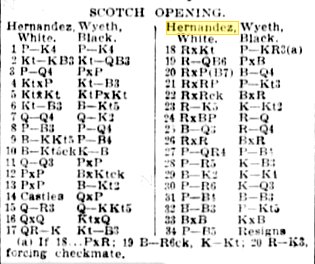The players met each other three times and in the first lap Showalter could only score a lone draw. He bounced back to score 2 points in the second lap, but only broke even in the third lap and so finished with a minus score. Even so, it was good enough to tie for second place!
The hero of the tournament was Wilbur L. Moorman (January 19, 1859 – September 07, 1934) of Lynchburg, Virginia. He's the guy the Virginia state championship is named after.
In a 1963 Chess Review article it was claimed he was the strongest player Virginia ever had. Looking at the list of the Virginia State champions though, to me at least, casts some doubt on that statement. His last tournament was the state championship in which he finished third a few days before he died.
In Tampa he was undefeated, scoring two points in the first lap, and two and a half in the second an third to finish first by three whole points.
I could find nothing on S.F.J. Traube of Punta Gorda, Florida, but assume he was related to Colonel Isaac Traube who founded Punta Gorda in 1885. Traube stared well, scoring 2.5 points in the first lap, but then fell off badly with one point in the second lap and only a lone draw in the third lap.
Nestor Hernandez was a Cuban living in Tampa. I could not find much on him except that he played in the 1952 U.S. Open which was held in Tampa. There he finished in a tie for places 26-36 (out of 76) with a 6.5-5.5 score.
Also, in the September 15th, 1918 issue of the Brooklyn Daily Eagle, Herman Helms wrote, “When the fourth annual championship of the National Correspondence Chess Association, now a part of the Correspondence Chess League of America, was started, in 1917, the Muskogee Chess Club of Muskogee, Oklahoma, represented by some players, made a unique offer of twenty-five dollars, to be divided as special brilliancy prizes. Nestor Hernandez of Tampa, Florida, who is one of a quartet, with Edward Lasker, playing in the final round, has submitted the following game, won from D. R. Wyeth of Philadelphia, for consideration in the distribution of those prizes.”
Tampa Final Standings:
1) Wilbur Moorman (+5 -0 =4) 7-2
2-3) Jackson W. Showalter (+3 -4 =2) and S. Traube (+3 -4 =2) 4-5
4) Nestor Hernandez (+1 -4 =4) 3-6
In Modern Chess Openings, 14th edition, GM Nick de Firmian says of the Albin Counter Gambit (1.d4 d5 2.c4 e5!?) that it “is somewhat more respectable” than the “entertaining” Blackmar-Diemer Gambit.
With the Albin, black gains the central wedge after 3.dxe5 d4, hoping this will lead to an attack. According to de Firmian, white gains the upper hand by 5.g3 and fianchettoing in King's B. The other two main responses of 5.Nbd2 and 5.a3 are not so clear. He wrote that in 1999, but as is usually the case, things have changed since then.
The gambit has been used by GMs Alexander Morozevich and Hikaru Nakamura. Earlier white tried a number of ideas, but fianchettoing the King's B won out. Then Morozevich hit upon 5...Nge7, a move that used to be played by Frank Marshall and later U.S. Master Dr. Ariel Mengarini. Thanks to Morozevich's success, attention shifted back to 5.Nbd2 instead of 5.g3.
Now the thinking of a few is that the Albin Counter Gambit is sound and it can take unprepared opponents by surprise, but the caveat is that black has to disregard material and must understand the initiative if he has any hope of being successful. It's worth a try is you're looking for something different.



No comments:
Post a Comment